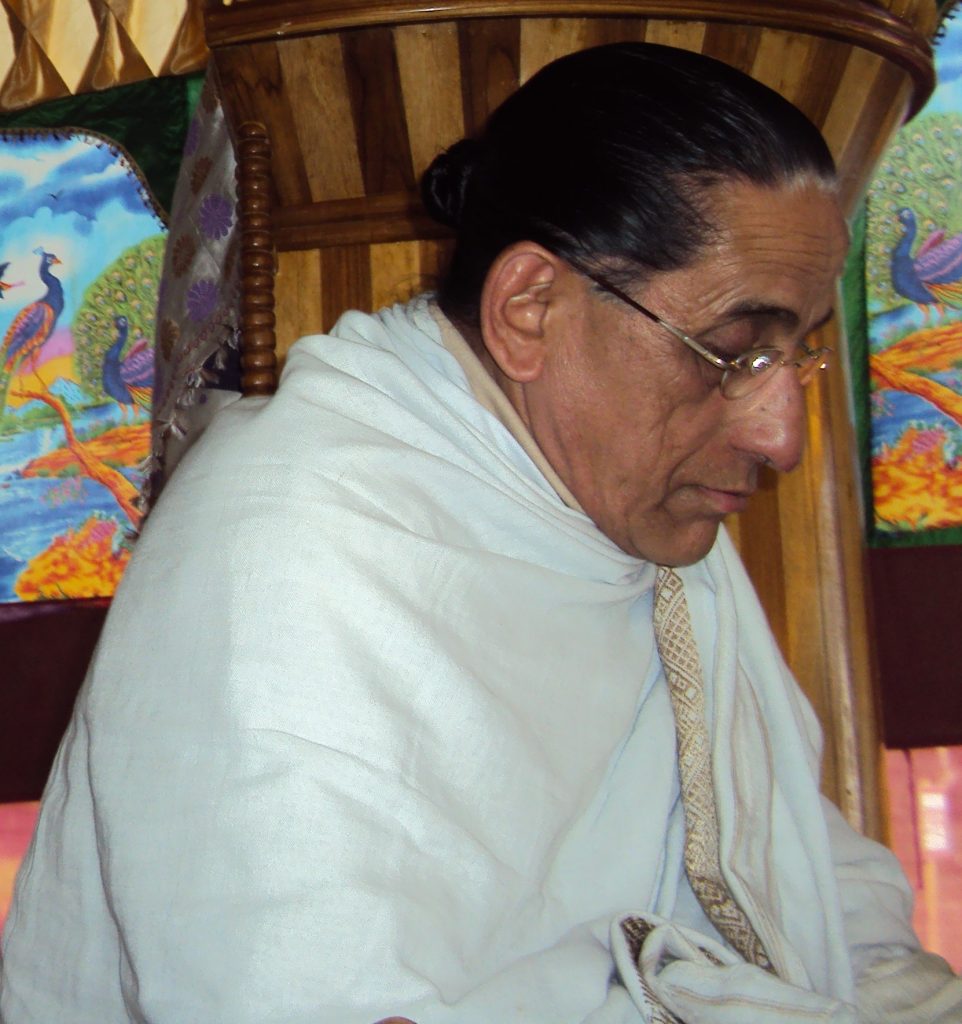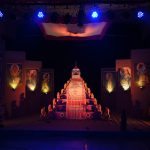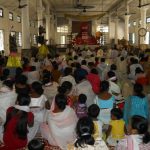I have known Sattradhikar Narayan Chandra Goswami for about twenty five years. It started with a disinformation campaign by some Chaitanyaites who were writing articles that Srimanta Sankaradeva had taken ideas from Chaitanyadeva. I wrote a series of articles in vernacular media of Assam in mid-nineties of the last century. This series first appeared in Natun Dainik and then reproduced in Dainik Batori. I presented strong arguments establishing originality of Srimanta Sankaradeva and his creations. When the case for national recognition of Sattriya dance came before Sangeet Natak Akademi, I saw people using my arguments successfully.
It was when this series of articles first appeared in newspaper that I came in contact with Narayan Chandra Goswami. He liked my articles very much. He appreciated my articles highly and suggested compilation in book form. I did it first in English in 2000 and then in Assamese in 2005. It was my idea to bring out the English version first as I wanted to send it to scholars outside, which I did. Narayan Chandra Goswami also suggested that I bring out the English version of the series. He understood the importance of conveying our ideas to the non-Assamese people outside Assam. This showed how pragmatic he was. There was regular communication between us through letters and also through telephone during this period.
However the first time we met in person was in 2006 only. A seminar was held in New Delhi in November that year titled ‘Sattra Darshan’. It was organised by Vivekananda Kendra Institute of Culture. We also travelled by the same flight. Perhaps seventeen Sattradhikars attended it in total. I too was one of the resource persons in this event. I found the lecture of Narayan Chandra Goswami better than other Sattradhikars. He spoke very seriously and people listened to him in rapt attention. This was one of the major events ever held in the capital city on the contributions of Srimanta Sankaradeva. Reporters of all leading newspapers attended the event in full strength. They all sat through both the technical sessions on 26th November, which is very rare. In my speech I highlighted the necessity of Asom Sattra Mahasabha and Srimanta Sankaradeva Sangha working together, apart from my other content. I continued this effort even later and always found Narayan Chandra Goswami supporting such initiative.
When I formed Society for Srimanta Sankaradeva in 2011 with some like-minded friends, we brought Asom Sattra Mahasabha, Eka Sarana Bhagavati Samaj and Srimanta Sankaradeva Sangha in the same platform in our events, especially to our website launch on 1st January, 2012. Srimanta Sankaradeva Sangha gave importance to my suggestion and invited Narayan Chandra Goswami in many of their programmes, which he readily accepted. Another person with similar progressive and liberal outlook was late Bhadrakrishna Goswami, the erstwhile President of Asom Sattra Mahasabha. These two stalwarts gave a new dimension to the entire movement of spreading the Srimanta Sankaradeva legacy. Unfortunately their liberal attitude was not shared by some others. I had to dissociate from the Nagaon session of Asom Sattra Mahasabha as some members opposed my use of both the terms Sattriya Nritya and Sankari Nritya; I had been earlier elected as editor of the souvenir and books to be brought out in that session.
I was associated with the effort for getting Majuli listed as world heritage by UNESCO. Government of Assam sent me to Archeological Survey of India office in New Delhi to present the case of Majuli after there were some discrepancies in the submission of dossier; some pages of the dossier had been torn deliberately while being despatched to UNESCO office. I and another member Bharat Saikia took it up strongly with ASI in New Delhi. Sometime around that time I was made a member of Majuli Cultural Landscape Management Authority. I noted that Narayan Chandra Goswami, who too was a member was more vocal than others in the meetings of MCLMA. When the content of MCLMA website was designed he too was present alongwith a few other selected persons in a meeting held at Jorhat. He pointed out several mistakes in the draft content and also appreciated my suggestions for developing the website.
The last meeting of MCLMA that I got to attend was held on 19th May, 2015 in Guwahati. Narayan Chandra Goswami also was present. M/S WAPCOS LTD had been entrusted with the task of preparing the Detailed Project Report and we were asked to give opinions in that meeting. That was the last meeting of MCLMA that I got to attend. I have not heard any more of it for last several years. I even do not know whether I continue to be a member of MCLMA or not. Two years ago I sent an email to the Chief Executive of MCLMA on 4th May 2018, which was not replied, not even acknowledged.
When the Natun Kamalabari Sattra of Narayan Chandra Goswami organised an All Assam Bhaona Samaroh in January, 2010, he invited me to deliver a speech on spiritual philosophy of Madhavadeva’s plays. I went there on 28th and delivered my speech on 29th January. I stayed in the guest house of his Sattra. He visited the room I stayed in. He entered inside and enquired of how I had put up. I had light refreshment in his Boha also at his invitation. Everything was without any formality. I found him accessible to anyone. There was no ego at all. There was no extra cloth on his mat nor did he maintain great distance from the guests while taking. I took a young friend Madhurjyamondit Boruah with me in that trip; he was overawed and became an ardent follower of Narayan Chandra Goswami thenceforth.
I have been associated with promotion of Majuli globally for about a decade. Our organization Society for Srimanta Sankaradeva organised the first ever international conference on Majuli on 8 July, 2012 in Guwahati. Several experts joined that conference. We invited Narayan Chandra Goswami to inaugurate it. He delivered a speech highlighting the characteristics of Majuli in the conference and also inaugurated a photo exhibition at the outset. Later I brought out a compilation of different articles on Majuli in 2017, which was published from New Delhi. It was titled Majuli : Resources and Challenges. I included the speech of Goswami in that book; I translated it myself from Assamese to English. The book became very famous and all leading national dailies reviewed it. It was also counted among the most important books published in the entire country during the year. I saw many competitive examinations setting questions about my book.
We were together in the centenary celebration of the illustrated institution Sankar Mandir of Nagaon on 14th February, 2011. In fact we two were the main speakers in the public meeting held on that occasion. Both of us dwelt on the philosophy of Srimanta Sankaradeva at length. He came frequently to Nagaon, sometime to attend the events of Nagaon Bhaona Samaroh. He put up at Tourist Lodge, where I called on him once. It was a very informal chat, devoid of all formality. He came across as an endearing personality in all these meetings. He listened to others also in rapt attention. Once I delivered a lecture on the distortion of Aharya of Bhaona in the Bhaona Samaroh organised by Sattriya Kendra in Srimanta Sankaradeva Kalakshetra, Guwahati in 2009. He listened to the entire speech sitting in the front row alongwith several other dignitaries and appreciated it. In fact that speech of mine became instrumental in launching a long research and initiatives on the part of both our Society for Srimanta Sankaradeva and Asom Sattra Mahasabha on Aharya. I gave another presentation in Sattriya Kendra in their Guwahati office that very year. These convinced all about the necessity to revive the true tradition of Aharya. We have been pursuing that even now.
There were some misadventures too. Asom Sahitya Sabha planned to bring out a Sankaradeva Kosh with Narayan Chandra Goswami as chief editor and myself as one of the editors. We started working and even completed the part allotted to me. Goswami was highly interested in the project. We had a meeting in the Guwahati office of Asom Sahitya Sabha. But somehow the project did not reach its final destination for so many reasons. Ego of different people clashed, killing the project midway. I did not take any honorarium for the ill-fated project. The part allotted to me was biography of all persons associated with the Sankaradeva movement. So many authors from all over Assam participated in the project; they kept on calling me for several years, but finally stopped calling when they too learnt how the project had been doomed. The soft-copy of the part allotted to me should be with the associate editor of my part even now.
Though I was not in regular touch with Narayan Chandra Goswami, I learnt from Rajib Dutta, a serious author of Majuli that he was appreciating my academic works on Srimanta Sankaradeva. In recent times I was keeping myself abreast of his falling health status through Rajib, who used to meet him frequently as well as Satyajit Mahanta, the Deka Sattradhikar. In fact I was getting almost daily health bulletins from Rajib. I realised that the Sattradhikar would not survive long but I tried to console his young admirers who seemed crestfallen. Now that he is no more the young brigade must carry on the task he had been pursuing lifelong.




